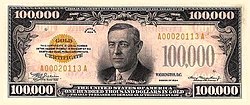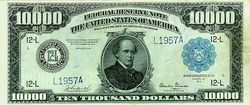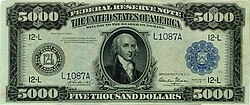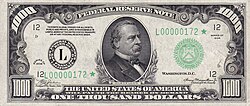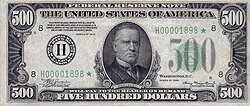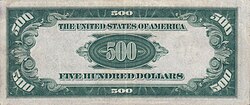Large denominations of United States currency: Difference between revisions
m Reverted edits by 169.204.229.122 to last version by JDspeeder1 (HG) |
No edit summary |
||
| Line 1: | Line 1: | ||
Fools. These are real, what kind of fool would go on this page and edit it just to be a dick, thats what http://uncyclopedia.wikia.com/wiki/Main_Page is for. Alex and Chris, these are real and not just anyone can edit this page. Rawr. |
|||
Today, the [[currency]] of the [[United States]], the [[United States dollar|U.S. dollar]], is printed in bills in [[Denomination (currency)|denominations]] of [[United States one-dollar bill|$1]], [[United States two-dollar bill|$2]], [[United States five-dollar bill|$5]], [[United States ten-dollar bill|$10]], [[United States twenty-dollar bill|$20]], [[United States fifty-dollar bill|$50]], and [[United States one hundred-dollar bill|$100]]. |
Today, the [[currency]] of the [[United States]], the [[United States dollar|U.S. dollar]], is printed in bills in [[Denomination (currency)|denominations]] of [[United States one-dollar bill|$1]], [[United States two-dollar bill|$2]], [[United States five-dollar bill|$5]], [[United States ten-dollar bill|$10]], [[United States twenty-dollar bill|$20]], [[United States fifty-dollar bill|$50]], and [[United States one hundred-dollar bill|$100]]. |
||
{| align=right |
{| align=right |
||
Revision as of 22:49, 17 December 2008
Fools. These are real, what kind of fool would go on this page and edit it just to be a dick, thats what http://uncyclopedia.wikia.com/wiki/Main_Page is for. Alex and Chris, these are real and not just anyone can edit this page. Rawr. Today, the currency of the United States, the U.S. dollar, is printed in bills in denominations of $1, $2, $5, $10, $20, $50, and $100.
At one time, however, it also included five larger denominations. High-denomination currency was prevalent from the very beginning of U.S. Government issue (1861). $500, $1,000, and $5,000 interest bearing notes were issued in 1861, and $10,000 gold certificates arrived in 1865. There are many different designs and types of high-denomination notes.
The high-denomination bills were issued in a small size in 1929, along with the $1 through $100 denominations. The designs were as follows:
- The $500 bill featured a portrait of William McKinley
- The $1,000 bill featured a portrait of Grover Cleveland
- The $5,000 bill featured a portrait of James Madison
- The $10,000 bill featured a portrait of Salmon P. Chase
- The $100,000 bill featured a portrait of Woodrow Wilson
The reverse designs featured abstract scrollwork with ornate denomination identifiers. All were printed in green, except for the $100,000. The $100,000 is an odd bill, in that it was not generally issued, and printed only as a gold certificate of Series of 1934. These gold certificates (of denominations $100, $1,000, $10,000, and $100,000) were issued after the gold standard was repealed and gold was compulsorily purchased by presidential order of Franklin Roosevelt on March 9, 1933 (see United States Executive Order 6102), and thus were used only for intra-government transactions. They are printed in orange on the reverse. This series was discontinued in 1940. The other bills are printed in black and green as shown by the $10,000 example (pictured at right).
Although they are still technically legal tender in the United States, high-denomination bills were last printed in 1945 and officially discontinued on July 14, 1969, by the Federal Reserve System.[1] The $5,000 and $10,000 effectively disappeared well before then: there are only about 200 $5,000 and 300 $10,000 bills known, of all series since 1861. Of the $10,000 bills, 100 were preserved for many years by Benny Binion, the owner of Binion's Horseshoe casino in Las Vegas, Nevada, where they were displayed encased in acrylic. The display has since been dismantled and the bills were sold to private collectors.
Circulation of high-denomination bills was halted in 1969 by executive order of President Richard Nixon, in an effort to combat organized crime.
For the most part, these bills were used by banks and the Federal Government for large financial transactions. This was especially true for gold certificates from 1865 to 1934. However, the introduction of the electronic money system has made large-scale cash transactions obsolete; when combined with concerns about counterfeiting and the use of cash in unlawful activities such as the illegal drug trade, it is unlikely that the U.S. government will re-issue large denomination currency in the near future. According to the US Department of Treasury website, "The present denominations of our currency in production are $1, $2, $5, $10, $20, $50 and $100....Neither the Department of the Treasury nor the Federal Reserve System has any plans to change the denominations in use today."[2]
Fake denominations
Numerous fake large denominations of US currency have been created by various individuals and organizations.
References
- ^ US BEP large banknote images, The Bureau of Engraving and Printing.
- ^ U.S. Treasury - FAQs: Denominations of Currency

